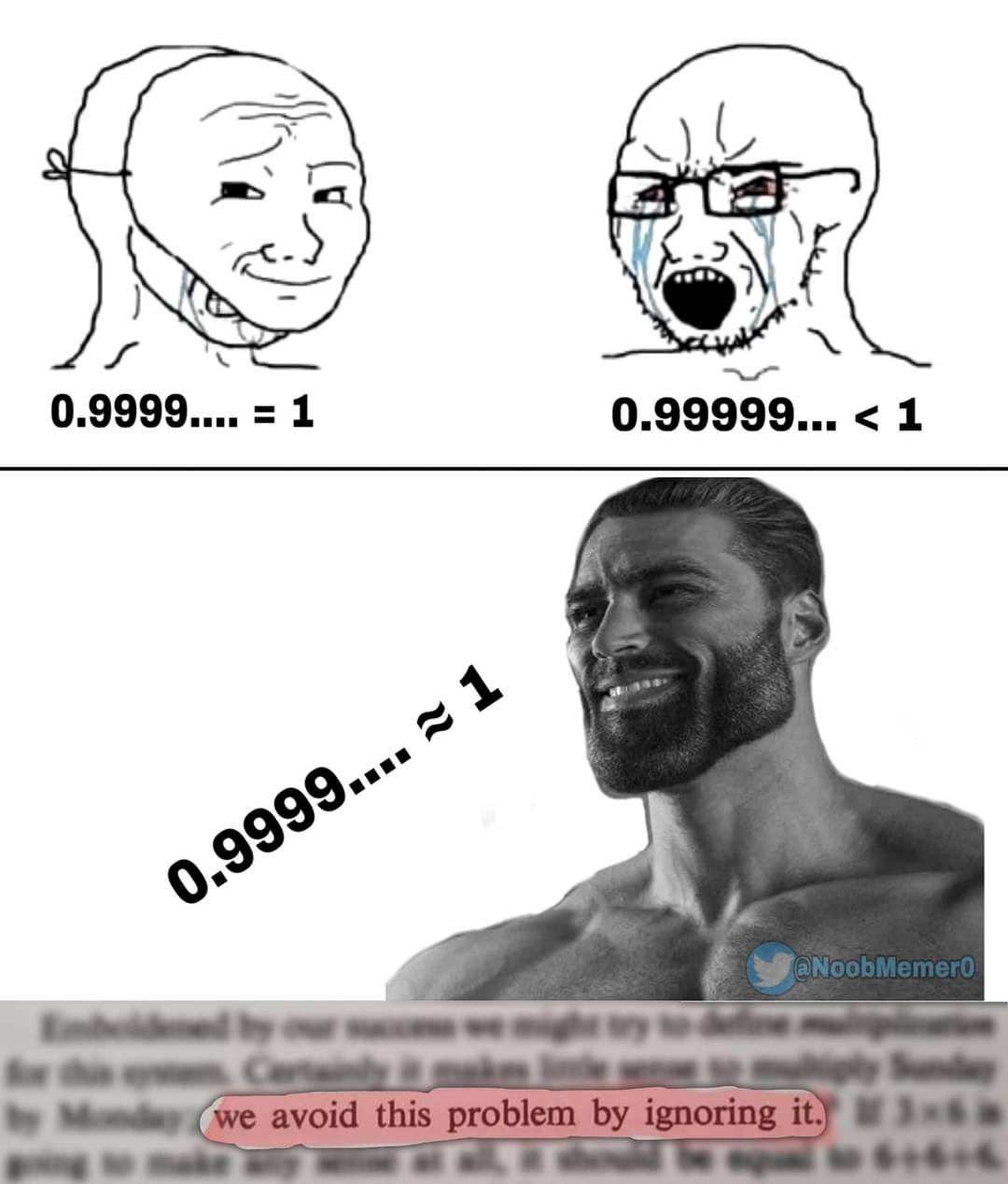this post was submitted on 27 Jun 2024
819 points (95.2% liked)
Science Memes
12952 readers
1615 users here now
Welcome to c/science_memes @ Mander.xyz!
A place for majestic STEMLORD peacocking, as well as memes about the realities of working in a lab.

Rules
- Don't throw mud. Behave like an intellectual and remember the human.
- Keep it rooted (on topic).
- No spam.
- Infographics welcome, get schooled.
This is a science community. We use the Dawkins definition of meme.
Research Committee
Other Mander Communities
Science and Research
Biology and Life Sciences
- [email protected]
- [email protected]
- [email protected]
- [email protected]
- [email protected]
- [email protected]
- [email protected]
- [email protected]
- [email protected]
- [email protected]
- [email protected]
- [email protected]
- [email protected]
- [email protected]
- [email protected]
- [email protected]
- [email protected]
- [email protected]
- [email protected]
- [email protected]
- [email protected]
- [email protected]
- [email protected]
- [email protected]
- !reptiles and [email protected]
Physical Sciences
- [email protected]
- [email protected]
- [email protected]
- [email protected]
- [email protected]
- [email protected]
- [email protected]
- [email protected]
- [email protected]
Humanities and Social Sciences
Practical and Applied Sciences
- !exercise-and [email protected]
- [email protected]
- !self [email protected]
- [email protected]
- [email protected]
- [email protected]
Memes
Miscellaneous
founded 2 years ago
MODERATORS
you are viewing a single comment's thread
view the rest of the comments
view the rest of the comments

I can't help but notice you didn't answer the question.
I'm sure I don't know what you mean by digit-wise operation, because my conceptuazation of it renders this statement obviously false. For example, we could apply digit-wise modular addition base 10 to any pair of real numbers and the order we choose to perform this operation in won't matter. I'm pretty sure you're also not including standard multiplication and addition in your definition of "digit-wise" because we can construct algorithms that address many different orders of digits, meaning this statement would also then be false. In fact, as I lay here having just woken up, I'm having a difficult time figuring out an operation where the order that you address the digits in actually matters.
Later, you bring up "incrementing" which has no natural definition in a densely populated set. It seems to me that you came up with a function that relies on the notation we're using (the decimal-increment function, let's call it) rather than the emergent properties of the objects we're working with, noticed that the function doesn't cover the desired domain, and have decided that means the notation is somehow improper. Or maybe you're saying that the reason it's improper is because the advanced techniques for interacting with the system are dissimilar from the understanding imparted by the simple techniques.
In base 10, if we add 1 and 1, we get the next digit, 2.
In base 2, if we add 1 and 1 there is no 2, thus we increment the next place by 1 getting 10.
We can expand this to numbers with more digits: 111(7) + 1 = 112 = 120 = 200 = 1000
In base 10, with A representing 10 in a single digit: 199 + 1 = 19A = 1A0 = 200
We could do this with larger carryover too: 999 + 111 = AAA = AB0 = B10 = 1110 Different orders are possible here: AAA = 10AA = 10B0 = 1110
The "carry the 1" process only starts when a digit exceeds the existing digits. Thus 192 is not 2Z2, nor is 100 = A0. The whole point of carryover is to keep each digit within the 0-9 range. Furthermore, by only processing individual digits, we can't start carryover in the middle of a chain. 999 doesn't carry over to 100-1, and while 0.999 does equal 1 - 0.001, (1-0.001) isn't a decimal digit. Thus we can't know if any string of 9s will carry over until we find a digit that is already trying to be greater than 9.
This logic is how basic binary adders work, and some variation of this bitwise logic runs in evey mechanical computer ever made. It works great with integers. It's when we try to have infinite digits that this method falls apart, and then only in the case of infinite 9s. This is because a carry must start at the smallest digit, and a number with infinite decimals has no smallest digit.
Without changing this logic radically, you can't fix this flaw. Computers use workarounds to speed up arithmetic functions, like carry-lookahead and carry-save, but they still require the smallest digit to be computed before the result of the operation can be known.
If I remember, I'll give a formal proof when I have time so long as no one else has done so before me. Simply put, we're not dealing with floats and there's algorithms to add infinite decimals together from the ones place down using back-propagation. Disproving my statement is as simple as providing a pair of real numbers where doing this is impossible.
Are those algorithms taught to people in school?
Once again, I have no issue with the math. I just think the commonly taught system of decimal arithmetic is flawed at representing that math. This flaw is why people get hung up on 0.999... = 1.